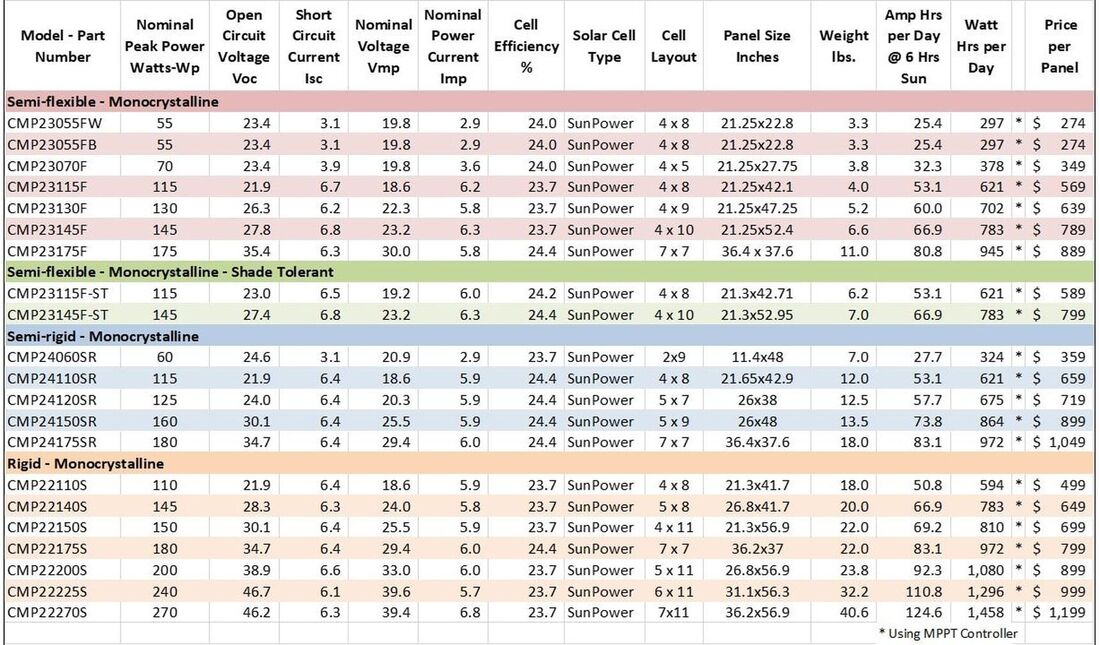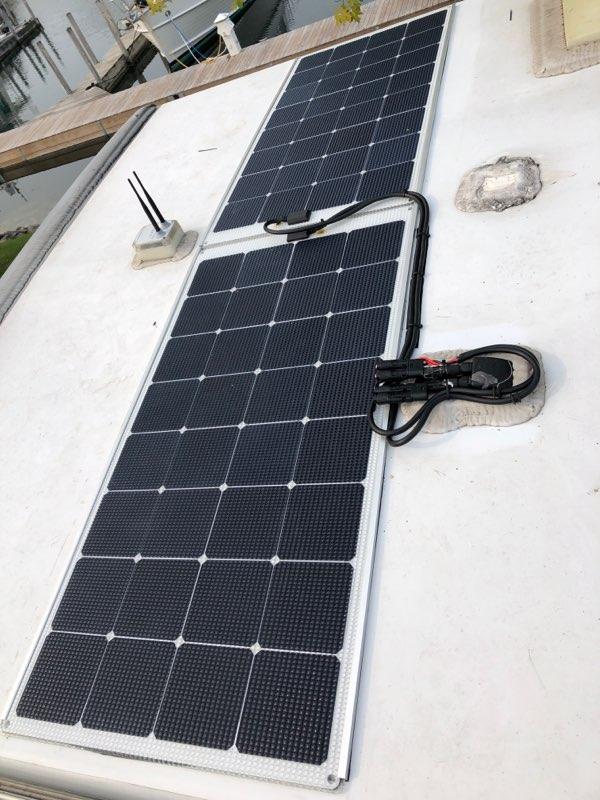RV Solar Panels - Highest Efficiency |
Flexible or Semi-rigid solar panels taped down with double sided VHB tape are excellent solutions for RVs. Easy installation, low windage, lightweight. We can walk you through your installation and wiring if you'd like, call 773-965-2546. RV solar kits are purchased here, detailed kit information here.
High Performance RV Solar Panel Specifications Summary
PERC / HJT Series
We also provide even higher end solar panels with A+ grade Sunpower cells, see here or grid below for data.
Grade A+ Sunpower Cell Solar Panels
Click below to learn more about specific solar panel types
A Few Facts About RV Solar Panels

Panel Solar Cell Quality - Because RVs have a relatively confined space, maximum power output per surface area is very important. The quality of the solar cells used in solar panels is a key factor in determining the panel output. Solar cells are passed under a standard light source and graded as to their output (1-10). Grades are grouped into classes. Class A (and A+) solar cells are grades 8-10, Class B solar cells are grades 4-7 and so on. Solar cell quality follows a bell curve; there are many more Class B solar cells than Class A. We at CMP specify only the best Class A-9 (A+) solar cells for use in our panels which results in a panel efficiency of 16-24%. Less expensive Class B and C panels are often used on land based solar farms where space is not an issue. Though more expensive, our customers have reported that our solar panels often outperform the performance rating on the panel label.
 Average 5 Sun Hours in a Day
Average 5 Sun Hours in a Day
High quality high performance solar cells will produce more power at various sun angles than lower quality solar cells; up to 30% more power. An important consideration in determining how much solar power you need is how many watt hours or amp hours of power you can expect to generate in a 24 hour period. Let's say you cruise in an area that receives an average of 5 hours of full sun a day. The average is computed based on the seasonal sun angle and the sun angle from morning through evening. A 100 watt solar panel with average efficiency solar cells may produce 100 watts x 5 hours or 500 watt hours of power in a day. At 13 volts that's about 38 amp hours in a day. A 100 watt panel with high efficiency solar cells will produce up to 30% more power in a 24 hour period or 100 watts x 6.5 effective hours or 650 watt hours of power in a day. At 13 volts, that's about 50 amp hours in a day. 38 amp hours vs. 50 amp hours in a day is significant for an RV. Add more panels in the mix, say 400 watts and we see 152 amp hours vs.200 amp hours, a difference of 48 amp hours. This simple analysis does not take into consideration the impact of clouds or shading both of which will make the disparity even greater. Clearly, the higher the quality of the solar cells the more power produced over time.
Panel Shape - The largest market for solar panels is commercial applications where many many panels are mounted on a roof or in a field. These panels are usually rectangular in shape often twice as long as wide. This shape is often not ideal for RV applications. Often a more square shape is preferable.
Marine Grade - It's no secret that the RVing can be tough on equipment. To withstand the rigors of various RV environments, solar panels should have strong stout anodized aluminum framing, should be well sealed and waterproof, and have the electrical box on the back of the panel encased in an inert non-corrosive waterproof material (like silicone) to protect the electronic components. Our solar panels are designed with bypass diodes to significantly reduce the impact of shading that so often occurs when RVing.
Choosing the right panel for your needs will require study and/or discussion with PV panel experts. Our staff at Custom Marine Products are ready to help you design the best solar system for your needs. Contact us via email or phone (773-965-2546) to discuss your project.
How much solar power do you need on your RV?
Check out our seminar slides titled Selecting the Proper Solar System and our tutorial titled Guide to Selecting and Sizing a Solar Charging System under our SUPPORT section. Working with Ed Foster our PV engineer, we have developed several worksheets to assist you in analyzing your on board power generation and consumption and estimating your solar power requirement. Print out our Solar Power Calculation Worksheet and use it as a guide to calculate your power generation requirement. Several other worksheets can be downloaded in our Manuals and Info section, and you can find a solar sizing app there as well.
Easy to Assemble RV Solar System Kits

Unique features of our semi-flexible marine grade RV solar panels include the following:
- Quality materials - We use impermeable ETFE laminates that will not cloud of degrade with exposure to intense UV light.
- Grade A+ SunPower solar cells - The panels are comparable in performance to our rigid panels.
- Mounting flexibility - Flexible panels will contour and flex against curved surfaces with a maximum bending radius of 30 degrees, ideal for mounting on an RV roof.
- Mounting options - Each panel can be affixed by high bond tape or screw mounting. Grommets are an added bonus for ease-of-installation. VHB tape from 3M is an excellent and fast solution for mounting flexible solar panels on RV roofs (similar to tape used to hold molding on cars).
- Plug and play - All panels come with industry standard waterproof MC4 connectors on 3 foot (1 meter) long pigtails. Walk on panels have a 6 foot duplex cable.
- Maximum output with shading - The panels are equipped with blocking and by-pass diodes so a shaded panel has minimal effect on the solar array performance. Good for when parked under trees and such.
- Purchase options - These panels can be purchased individually or as a complete easy to install kit.
- Durable - Although not recommended, the flexible panels can be lightly stepped on, walk on panels can be driven on, rigids don't step on at all as they are glass.
All CMP our solar panels are high quality, high output Class A+ marine grade and backed with a 5 year manufacturers and CMP warranty.
What are the best RV solar panels?
The best RV solar panels have five essential components:
1. Sunpower cells - even if a cell is partially shaded they still produce power. Sunpower's A+ grade cells (Maxeon) are among the best available putting out up to 23.7% efficiency.
2. Potted (silicone filled) junction boxes - so saltwater cannot corrode the electronics.
3. Easily mountable, either semi-flexible or rigid panels with stout anodized aluminum framing, depending on the application.
4. A+ grade solar cell quality. Cheaper panels will have lower quality, less efficient cells. Space is always at a premium in RV applications so the highest efficiency cells available are imperative. Highly efficient cells produce considerably more power at lower sun angles than lower grade cells.
5. Have bypass diodes to significantly reduce the impact of shading that often occurs when RVing.
What is the difference between a cheap RV solar panel and an expensive RV solar panel?
High quality high performance solar cells will produce more power at various sun angles than lower quality solar cells; up to 30% more power. An important consideration in determining how much solar power you need is how many watt hours or amp hours of power you can expect to generate in a 24 hour period. Let's say you RV in an area that receives an average of 5 hours of full sun a day. The average is computed based on the seasonal sun angle and the sun angle from morning through evening. A 100 watt solar panel with average efficiency solar cells may produce 100 watts x 5 hours or 500 watt hours of power in a day. At 13 volts that's about 38 amp hours in a day. A 100 watt panel with high efficiency solar cells will produce up to 30% more power in a day or 100 watts x 6.5 effective hours or 650 watt hours of power in a day. At 13 volts, that's about 50 amp hours in a day. 38 amp hours vs. 50 amp hours in a day is significant in an RV. Add more panels in the mix, say 400 watts and we see 152 amp hours vs.200 amp hours, a difference of 48 amp hours. This simple analysis does not take into consideration the impact of clouds or shading both of which will make the disparity even greater. Clearly, the higher the quality of the solar cells the more power produced over the course of a day.
How much solar power do I need on my RV?
It depends on how much power your RV uses and what you are trying to accomplish. Running a radio for an afternoon will use considerably less power than a refrigerator, lights, water pump, and a computer while RVing full time. Sizing your solar system is not an exact science and it may be best to leave space on your solar controller to size up as needed. As they say, you can never have too much power! An abundance of power is much more fun than a deficit. We have a google docs sheet available for edit to help you figure out the power you need, see it here: https://docs.google.com/spreadsheets/d/1CnNTXkCZ6kqdcLZ_kXOVL3F_L_zgdWxvnv8pe7XjC8A/edit?usp=sharing Of course feel free to call us any time to discuss your needs, we've built hundreds of solar systems and are happy to share our knowledge.
Can I power my refrigerator with a 120 watt panel?
Most likely yes. It will depend on the battery bank you have to run it when the sun isn't shining. Refrigerators on RVs are one of the most frequent uses for solar power. Here is a google docs sheet available to help you figure out the power you need on your RV: https://docs.google.com/spreadsheets/d/1CnNTXkCZ6kqdcLZ_kXOVL3F_L_zgdWxvnv8pe7XjC8A/edit?usp=sharing Generally a refrigerator in an RV draws 5 amps and is on we estimate 10-12 hours a day, depending on temperature outdoors.
Home Page Solar Panels Mounting Kits Product Page Marine Solar Systems Gallery of Installations Customer Comments Contact Us
Call 248 705-8337 or email [email protected]
Article On How To Size Your Solar Panels For Your Boat
Customer Reviews Return Policy Privacy Policy Shipping Times/Rates









